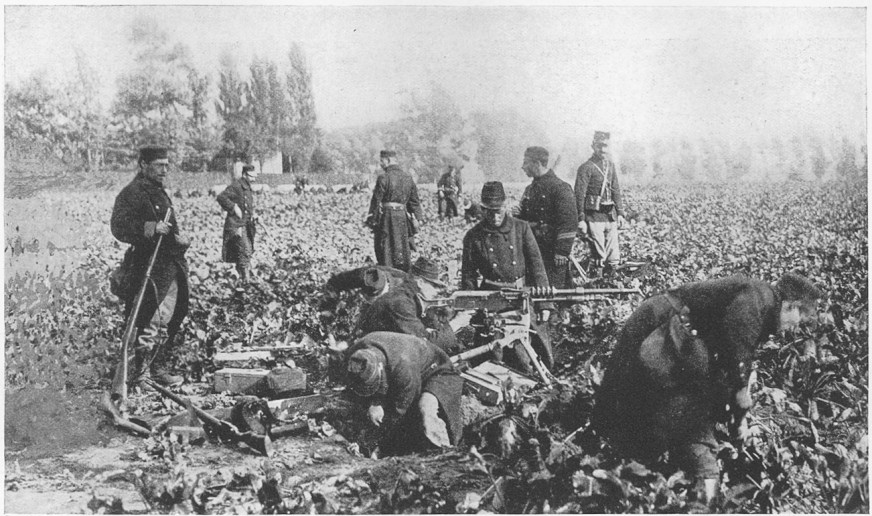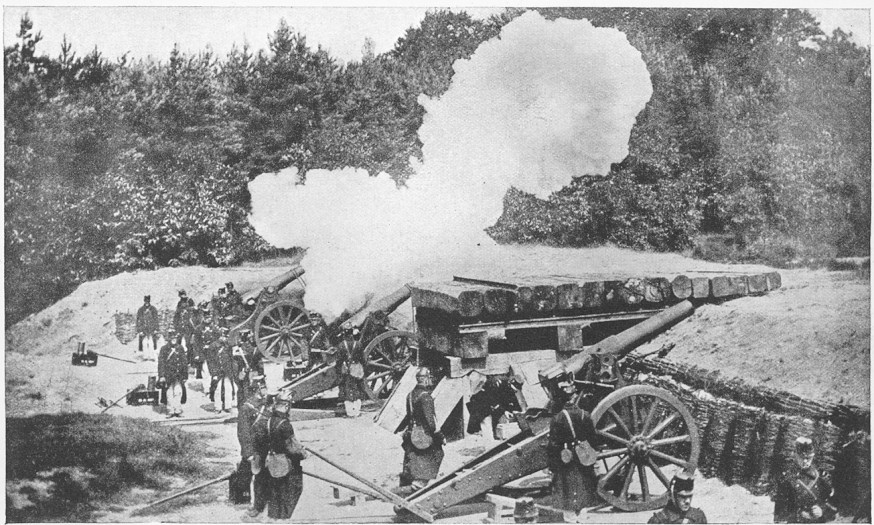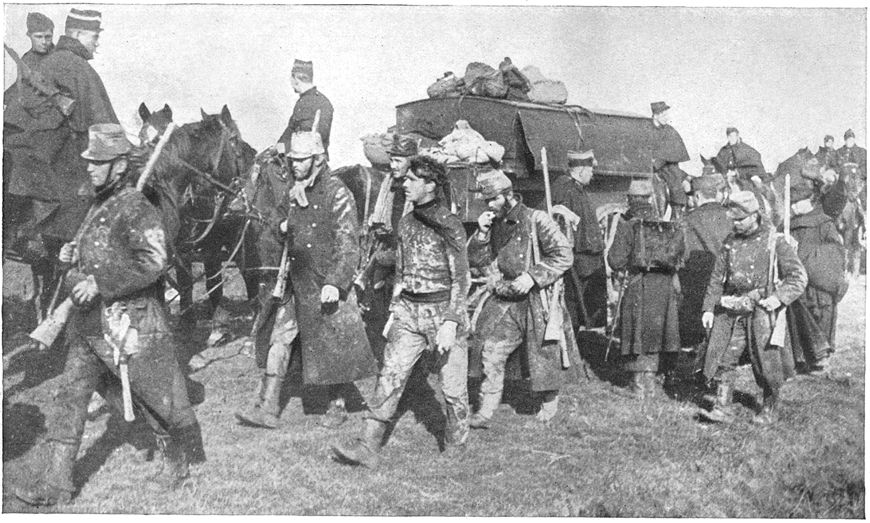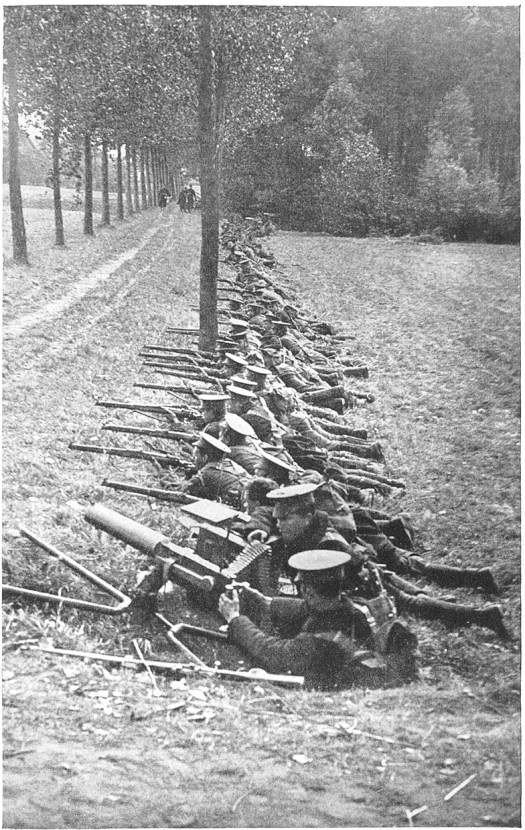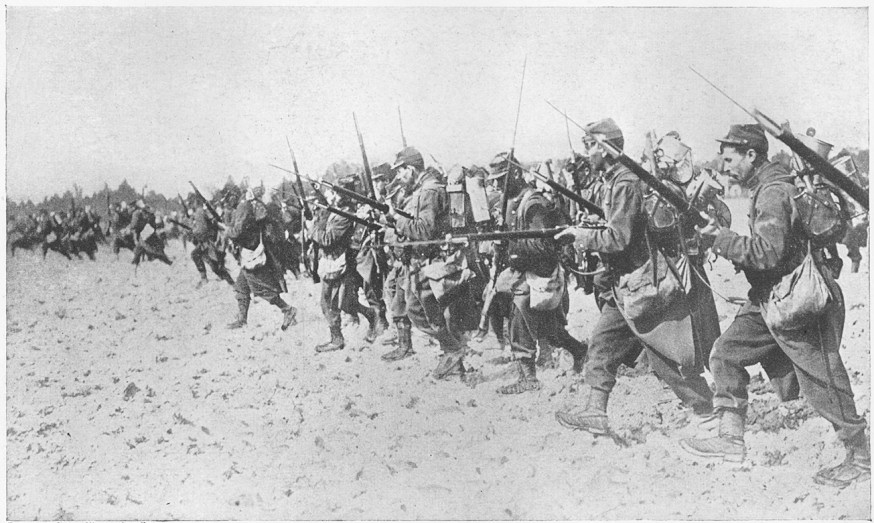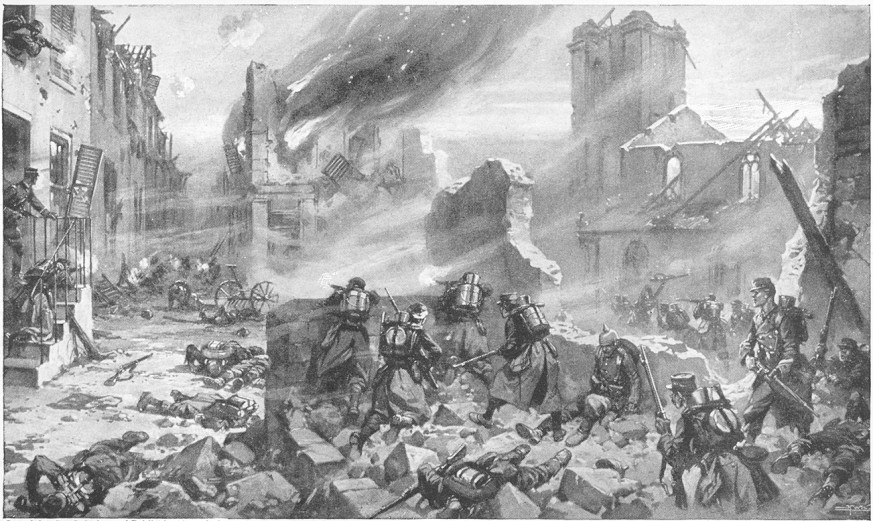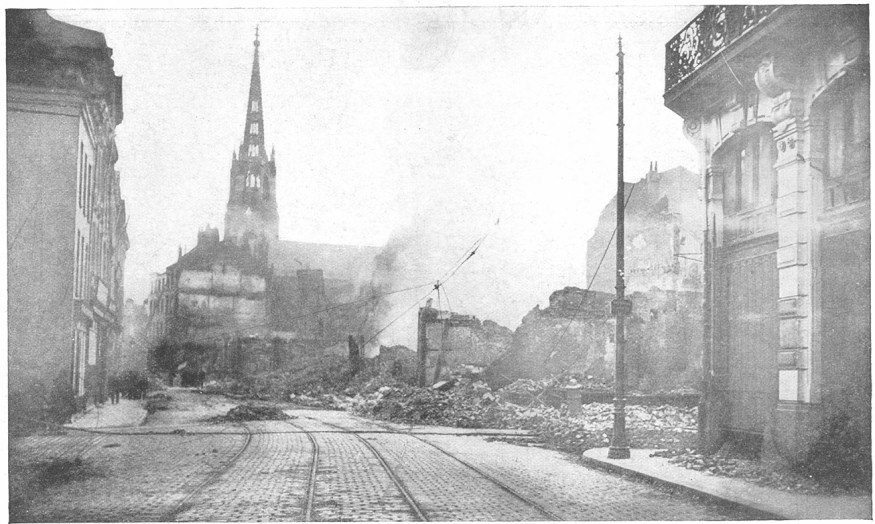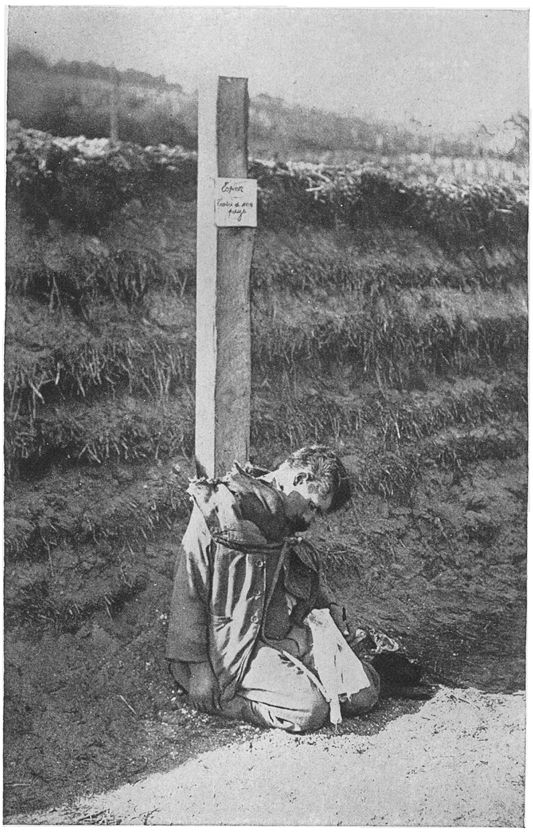|
|||||||||||||||||||||||||
|
|
<< Previous | Contents | Next >> CHAPTER II The Invasion of France and BelgiumGermany began the war on the Western front before it was declared, and on 1-2 August German cavalry crossed the French frontier between Luxemburg and Switzerland at three points in the direction of Longwy, Lunéville, and Belfort. But these were only feints designed to prolong the delusion that Germany would attack on the only front legitimately open to warfare and to delay the reconstruction of the French defence required to meet the real offensive. The reasons for German strategy were conclusive to the General Staff, and they were frankly explained by Bethmann-Hollweg to the British ambassador. There was no time to lose if France was to be defeated before an effective Russian move, and time would be lost by a frontal attack. The best railways and roads from Berlin to Paris ran through Belgium; the Vosges protected more than half of the French frontier south of Luxemburg, Belfort defended the narrow gap between them and Switzerland, and even the wider thirty miles' gap between the northern slopes of the Vosges and Luxemburg was too narrow for the deployment of Germany's strength; the way was also barred by the elaborate fortifications of Verdun, Toul, and Nancy. Strategy pointed conclusively to the Belgian route, and its advantages were clinched by the fact that France was relying on the illusory scrap of paper. Her dispositions assumed an attack in Lorraine, and her northern fortifications round Lille, Maubeuge, and Hirson were feeble compared with those of Belfort, Toul, and Verdun. Given a rapid and easy march through Belgium, the German armies would turn the left flank of the French defence and cut it off from the capital. Hence the resistance of Belgium had a great military importance apart from its moral value. To its lasting honour the Belgian Government had scorned the German proposal for connivance even in the attractive form which would have limited the German use of Belgian territory to the eastern bank of the Meuse.
Haste and contempt for the Belgian Army, whose imperfect organization was due to a natural reliance on the neutrality which Germany had guaranteed, accounted for the first derangement of German plans. The invasion began towards Visé, near the Dutch frontier where the direct road from Aix to Brussels crosses the Meuse, but the main advance-guard followed the trunk railway from Berlin to Paris via Venders and Liège. It was, however, inadequately mobilized and equipped, and was only intended to clear away an opposition which was not expected to be serious. The Belgians fought more stubbornly than was anticipated; and aided by Brialmont's fortification of Liège, although his plans for defence were not properly executed, they held up the Germans for two days in front of the city. It was entered on 7 August, but its fall did not give the Germans the free passage they wanted; for the forts on the heights to the north commanded the railway, and the Germans contented themselves with bringing up their transport and 11 2 in. howitzers. Brialmont had not foreseen the explosive force of modern shells, and two days' bombardment on the 13th-15th reduced the remaining forts, in spite of their construction underground, to a mass of shell-holes with a handful of wounded or unconscious survivors. The last to be reduced was Fort Loncin, whose gallant commander, General Leman, was found poisoned and half-dead from suffocation. He had succeeded in delaying the German advance for a momentous week.
No more could be done with the forces at his disposal, and the German masses of infantry were pouring across the Meuse at Visé, towards Liège by Verviers, up the right bank of the Meuse towards Namur, and farther south through the Ardennes. The German cavalry which spread over the country east and north-east of Brussels and was sometimes repulsed by the Belgians, was merely a screen, which defective air-work failed to penetrate, and the frequent engagements were merely the brushes of outposts. Within a week from the fall of Fort Loncin half of Belgium was overrun and the real menace revealed. Belgium was powerless before the avalanche, and its only hope lay in France. But the French Army was still mobilizing on its northern front, and its incursions into Alsace and Lorraine did nothing to relieve the pressure. The Belgians had to fall back towards Antwerp, uncovering Brussels, which was occupied by the Germans on the 20th and mulcted in a preliminary levy of eight million pounds, and leaving to the fortifications of Namur the task of barring the German advance to the northern frontiers of France. Namur proved a broken reed. The troops which paraded through Brussels with impressive pomp and regularity were only a detail of the extreme right wing of the invading force; the mass was advancing along the north bank of the Meuse and overrunning the whole of Belgium south and east of the river. On the 15th an attempt to seize Dinant and the river crossing above Namur was repulsed by French artillery; but there was apparently no cavalry to follow up this success, and the Germans were allowed to bring up their heavy howitzers for the bombardment of Namur without disturbance. It began on the 20th, and, unsupported by the Allied assistance for which they looked, the Belgians were panic-stricken; on the 23rd the city and most of the forts were in German hands though two resisted until the 26th. The Germans had not, as at Liège, wasted their infantry in premature attacks, and with little loss to them, a fortress reputed impregnable had been captured, the greater part of the southern Belgian Army destroyed, and the provisional plan of French defence frustrated. The fall of Namur was the first resounding success of the Germans in the war.
Its loss was not redeemed by the French offensive in Alsace and Lorraine. On 7 August a weak French force advanced through the Belfort gap and, finding still weaker forces to oppose it, proceeded to occupy Altkirch and Mulhouse, while a proclamation by General Joffre announced the approaching liberation of the provinces torn from France in 1870. It was a feeble and ill-conceived effort to snatch a political advantage out of a forbidding military situation. German reinforcements swept up from Colmar and Neu Breisach, and on the both the French were back within a few miles of the frontier, leaving their sympathizers to the vengeance of their enemies. More legitimate though not more successful was the French thrust in Lorraine. It had other motives than the political: it would, if pushed home, menace the left of the German armies in Belgium and disturb their communications; and a smaller success would avert the danger of a German advance in Lorraine which would threaten the right of the French on the Meuse. Accordingly, Generals Pau and de Castelnau, commanding the armies of Alsace and Lorraine respectively, ordered a general advance on the 10th. At first it met with success: the chief passes of the Vosges from Mt. Donon on the north to the Belfort gap were seized; counter-thrusts by the Germans towards Spincourt and Blamont in the plain of Lorraine were parried; Thann was captured, Mulhouse was re-occupied, and the Germans looked like losing Alsace as far north as Colmar. German Lorraine seemed equally insecure, for on the 18th Castelnau's troops were in Saarburg cutting the rail and roads between Strassburg and Metz. The Germans, however, were not unprepared: their Fifth Army, under the Crown Prince Rupprecht of Bavaria, came down from Metz and fell upon the exposed French left, which was routed with great losses in guns and prisoners on the 21st. Not only did the invasion collapse, but the Bavarians pushed across the French frontier nearly as far as Toul and occupied Lunéville, compelling also a French retreat from the passes of the Vosges. General Pau had soon to follow suit and retire again from Mulhouse and all but the south-west corner of Alsace.
The operations in Alsace and Lorraine had dismally failed to discount the advance of the Germans through Belgium or even to impede the march of their centre through Luxemburg and the Ardennes. At the end of three weeks France was still in the throes of mobilization: the original scheme of defence along the Franco-German frontier had been upset by the German attack through Belgium; and second thoughts had fared little better at Namur. The shortest line of defence after the Germans had broken through at Liège was one running from Antwerp to Namur, and the shortest line is imperative for the weaker combatant. But the Germans were well across it when they entered Brussels, and with the fall of Namur the hinge upon which depended the defence of the northern frontier of France was broken. It was to an almost forlorn hope that the British Army was committed when it took its place on the left of the French northern armies at Mons to encounter for the first time since Waterloo the shock of a first-rate European force. But for its valour and the distraction caused by the Russian invasion of East Prussia, Paris and possibly the French armies might not have been saved.
It was a meagre force for so great a responsibility, but far from the "contemptible little army" it was falsely believed to have been called by the Kaiser. The men were all volunteers who had enlisted for seven years' service with the colours as against the three years' service of the Germans and the French; and on an average they had seen far more actual fighting than the Germans, who contemptuously dismissed this experience as colonial warfare. If in the science of tactics and strategy the British was inferior to the German Army, its marksmanship and individual steadiness were unequalled; and under anything like equal conditions British troops proved themselves the better men. But the conditions were never equal during the first two years of the war owing to the German superiority in numbers and in artillery; and there was a third cause of inequality due to the different military systems of the two countries. Universal service enabled Germany to select the ablest men--at least from the middle and upper classes--to officer and command her armies. In England before the war only an infinitesimal fraction of her youthful ability found its way into the army. Independent means and social position rather than brains were the common qualifications for a commission; and what there was to be said for such a system so long as fighting was mainly a matter of physical courage and individual leadership lost its validity when war became a matter of science and mechanical ingenuity. The fact that four of the six British army-commanders (Plumer, Byng, Rawlinson, Cavan) in the West at the end of the war were old Etonians, testifies to more things than their military skill; and it was a characteristic irony that from first to last the British armies should have been commanded by cavalry officers in a war in which cavalry played hardly any part.
The commander-in-chief was Sir John French, who had made his reputation as a cavalry leader in the Boer War and had been chief of the imperial staff since 1911. As inspector-general of the forces from 1907 to 1911 he had a good deal to do with Lord Haldane's reorganization of the British Army, and as chief of the staff he was largely responsible for the equipment of the Expeditionary Force and the agreement with the French Government with regard to its dimensions and the way in which it should be used. He was the obvious general to command it when it came to the test. With similar unanimity the popular voice approved of the appointment of Lord Kitchener as Secretary of State for War on 5 August. The Expeditionary Force consisted of three army corps, each comprising two divisions, and a cavalry division under Allenby. The First Army Corps was commanded by Sir Douglas Haig, the youngest lieutenant-general in the army, and the second by Sir James Grierson, its most accomplished student. Unhappily Grierson died suddenly soon after the landing, and he was succeeded by Sir H. Smith-Dorrien, who, like French, had made his name in South Africa. The Third Corps, under Sir W. Pulteney, came later into the field. The embarkation began on 7 August, less than three days after war had been declared, and the Government showed a sound confidence in our little-understood command of the sea when it risked the whole of our effective fighting force by sending it across the Channel to assist the French and thus abandoning the defence of British shores to the British Navy. By the 16th the transportation had been accomplished without a hitch or loss of any kind. It was an achievement which even domestic faction failed to belittle until time itself had effaced it from popular recollection.
From Boulogne and from other ports the troops were sent up to the wavering line of battle along the Franco-Belgian frontier. They came not to win a victory but to save an army from disaster. The mass of French reserves were in Lorraine or far away to the south, and the safety of the French line on the northern front had depended upon the assumed impregnability of Namur and an equally fallacious underestimate of the number of German troops in Belgium. Three French armies, the Third, the Fourth, and the Fifth, were strung along the frontier from Montmédy across the Meuse and the Sambre to a point north-west of Charleroi, where the British took up their position stretching through Binche, Mons, and along the canal from Mons to Condé. Far away to the south-west was a French Territorial corps in front of Arras, and at Maubeuge behind the British centre was a French cavalry corps under General Sordet. The French staff anticipated a defeat of the German attack on these lines and then a successful offensive, and military critics in England even wrote of the hopeless position of the Germans under Von Buelow and Von Kluck thrust far forward into a cul-de-sac in Belgium with the French on their left at Charleroi, the British on their right front at Mons, and the Belgians on their right rear before Antwerp. The German calculation was that the Belgians had been effectively masked by a corps detached north-westwards from Brussels, that the Duke of Württemberg and Von Hausen had troops enough to force the Meuse, drive in the French right, and threaten the centre at Charleroi, and that Von Buelow could cross the Sambre and Von Kluck encircle the British flank. The strength which the Germans developed in Belgium and the extension of their right wing are said to have been an afterthought due to the intervention of the British Expeditionary Force; but the original German plan required some such modification when the presence of British troops lengthened the line of French defence.
The first two army corps, under Haig to the right and Smith-Dorrien to the left, were in position on Saturday the 22nd hard at work throwing up entrenchments and clearing the ground of obstacles to their fire. That day was more eventful for the French, and it is not quite clear why they were not assisted by a British offensive on their left. On the right, the Third and Fourth French armies under Ruffey and Langle de Cary had advanced from the Meuse to attack the Germans across the Semois. They were severely checked and withdrew behind the Meuse, while an unsuspected army of Saxons under Von Hausen attacked the right flank of the Fifth French army under Lanrezac which lay along the Sambre with its right flank resting on the Meuse. The fall of Namur in the angle of the two rivers made Von Hausen's task comparatively easy, and the Fifth army, which was also attacked by Von Buelow in front, fell back in some confusion. A breach was thus made in the French line, and Von Hausen turned left to roll up the Fourth and Third armies of Langle de Cary and Ruffey; they, too, in their turn retreated in some haste, and the Germans were free to concentrate on the British. They had cleared their left and centre of danger, and Von Kluck was able on the 23rd not only to face our troops with superior forces in front, but to outflank them towards the west and bring Von Buelow down upon them from Charleroi on the east. He had at least four army corps with which to crush the British two, and our 75,000 men were spread out on a line of twenty-five miles thinner far than the French line just broken at Charleroi. Finally, owing to defective staff-work and the confusion of the French retreat, they were left in utter ignorance of what had happened, and faced the German attack as if they were part of one unbroken front instead of being a fragment round which the tide of battle surged, and under the impression conveyed to them on their arrival at the scene of action that their opponents numbered little more than one or at most two army corps.
Fighting began at 12.40 p.m. on Sunday the 23rd with a bombardment from between five and six hundred German guns along the whole twenty-five miles of front. It did surprisingly little damage in spite of the spotting by German aeroplanes; and when the German infantry came forward in massed formation, they discovered that their shelling had had no effect upon the moral of our troops or the accuracy of their rifle-fire. The Germans fought, of course, with obstinate courage and advanced again and again into the murderous fire of our rifles and machine guns and against occasional bayonet charges. But their own shooting went to pieces under the stress, and the frontal attack was a failure. Success there could not, however, ward off Von Buelow's threat to our right flank, and under the converging pressure Binche and then Mons itself had to be evacuated. But it was the long-delayed news of the French defeat and withdrawal on the whole of the rest of the line, coupled with more accurate information about the size of the German force, that determined the abandonment of the British position. Sir John French had to hold on till nightfall, but orders were given to prepare the way for retreat. The weary troops were to have a few hours' rest and start at daybreak. Their retreat was covered by a counter-attack soon after dawn by the First Division on the right which suggested to the Germans that we had been strongly reinforced and intended an offensive. Meanwhile Smith-Dorrien moved back five miles from the Canal, and then stood to protect the withdrawal of the First Division after its feint attack. It was a heavy task, and the 9th Lancers suffered severely in an attempt to hold up the Germans at Audregnies. But by Monday afternoon Haig's First Army Corps was back on the line between Maubeuge and Bavai, and Smith-Dorrien fell into line from Bavai westwards to Bry.
The design was to offer a second battle in this position, and entrenchments were begun. The fortress of Maubeuge and the Sambre gave some protection to the British right, but the Sambre was only of use in front if the Meuse was held by the French on the right and Von Kluck could not outflank on the left. Neither of these conditions was fulfilled: Von Kluck had seized Tournai and captured the whole of the French Territorial brigade which attempted to defend it, while the Meuse had been forced and the three French armies were in full retreat. A battle on the Maubeuge-Bry line would invite an encirclement from which the British had barely escaped at Mons, and the retreat was reluctantly continued to Le Cateau. Marching, the First Army Corps along the east of the Forest of Mormal and the Second along the west, our troops reached at nightfall on the 25th a line running from Maroilles through Landrecies and Le Cateau to Serainvilliers near Cambrai; but they had little rest. About 10 p.m., amid rain and darkness, the Germans got into Landrecies. In the fierce hand-to-hand struggle which ensued, the individual resourcefulness of our men gave them the advantage, and the Germans were driven out by detachments of the Grenadier, Coldstream, and 1st Irish Guards. They were simultaneously repulsed at Maroilles with some French assistance; but daybreak saw a third and more powerful attack delivered on Le Cateau. Sir John French had told Smith-Dorrien the night before that he was risking a second Sedan by a stand. But Smith-Dorrien thought he had no option. For eight hours on the 26th his men, reinforced by Snow's Division, but outnumbered in guns by nearly four to one, held their own, until another envelopment was threatened by Von Kluck. Fortunately the struggle had apparently exhausted the Germans; Sordet's cavalry had ridden across Smith-Dorrien's front and protected his left from envelopment; and the remnants of the three divisions were able to withdraw. The retreat was harrowing enough, and the 1st Gordons, missing their way in the dark, fell into the hands of the Germans and were all killed, wounded, or taken prisoners. But Le Cateau had taken the sting out of the German pursuit, and touch was at last regained with French forces to the east, with a newly-formed corps under D'Amade to the west, and with a Sixth French army which Maunoury was collecting on the Somme. On the evening of Friday the 28th Smith-Dorrien reached the Oise between Chauny and Noyon and Haig at La Fère. The First Army Corps had marched by Guise; the loss of a detachment of Munsters by misadventure early on the 27th was redeemed by the defeat on the 28th of two German columns by two brigades of Allenby's cavalry led by Gough and Chetwode. That night the Expeditionary Force had its first real sleep since Sunday, and next day there were no marching orders.
The British Army had saved itself and a good deal else by its courage, skill, and, above all, its endurance. But there was much that was lost in men, material, and ground. The fortification of the French frontier south and west of Mons was obsolete, and the country had been denuded of troops save a few Territorials in the process of mobilization. Maubeuge was the only fortress that made a stand, and Uhlans swept across Belgium as far as the Lys and down upon Lille and Arras with the object of cutting communications between the British Army and its bases at Boulogne and Dieppe. Some resistance was offered at Bapaume, where the arrival of a British detachment delayed the German advance until Amiens had been evacuated and the rolling stock removed. But the threat was sufficiently serious to induce Sir John French to move his base as far south as St. Nazaire at the mouth of the Loire, and the Germans could, had they been so minded, have occupied the Channel ports as far as the Seine. But they were not calculating on a long war or a serious contest with British forces for the control of Flanders, and their object was to destroy the French armies and dictate a peace at Paris before the autumn leaves began to fall. They seemed to be making excellent progress towards that end. Sir J. French, indeed, took a sombre view of our losses at Le Cateau, and apparently it needed a visitation from Lord Kitchener on 1st September to retain the British Army in co-operation with the French. The fall of Namur, the battles of Charleroi and Mons, and the defeat of the French on the Semois were followed by the rout of Ruffey's and Langle's armies on the Meuse. They stretched north-westwards from Montmédy by way of Sedan and Mezières down the Meuse towards Dinant and Namur. But their left flank had been turned by Von Hausen's victory and the fall of Namur; and on the 27th Von Hausen, wheeling to his left, rolled up the French left wing while the Duke of Württemberg and the Crown Prince attacked all along the front. Ruffey had to seek safety in the Argonne, while Langle's army made for Rethel on the Aisne. On the 28th Longwy, the last French fortress north of Verdun, capitulated after a stout resistance. The defence of the frontier had collapsed, and the hopes that were entertained of resistance along the upper Aisne and thence by Laon and La Fère towards St. Quentin, proved delusive. Lanrezac's Fifth army turned on the 29th between Vervins and Ribemont, and near Guise inflicted on the Germans the most serious check to their advance. This reaction was not helped by the British retreat on Lanrezac's left, and its principal value was to protect that withdrawal. Nor was it better supported on the right. The Third and Fourth French armies were too severely hustled in their retreat to make a stand, and the reserves were still far away to the south. On the 28th-29th the Aisne was forced at Rethel, and Reims and Chalons were abandoned to the enemy; and La Fère and Laon followed on the 30th. The British fell back from the Aisne and the Oise through the forests of Villers-Cotterets and Compiègne towards the Marne. At Néry on 1 September a battery of Royal Horse Artillery was almost wiped out, and the guns were only saved by a gallant cavalry charge of the 1st Brigade; and on the same day a hard rearguard defence had to be fought by the 4th Guards Brigade. On the 3rd they reached the Marne, but it too was abandoned farther east without resistance, and on the 5th the Expeditionary Force was concentrated behind the Grand Morin. A retreat, upon the successful conduct of which depended the existence of the Force, the security of France, and the cause of the Entente, had been successfully accomplished by the skill of its commanders and still more by the fortitude and unquenchable spirit of the men. The French, too, showed a steadiness in misfortune for which their enemies had not looked; their reverses had been more severe, and their preparation less complete than our own, and a high morale was required for armies to react against such a run of ill-success with the effectiveness that was presently displayed upon the Marne. A public on both sides of the Channel which was unfamiliar with the elements of military science and history, looked, as soon as it was allowed to learn the facts about the German advance, for the investment of Paris and regarded the French capital as the objective of the German invasion. But Napoleon's maxim that fortresses are captured on the field of battle was even truer in 1914 than it was a century earlier; for only the dispersal of the enemy enables an army to bring up the heavy artillery needed to batter down modern fortifications, and the great war saw no sieges worth the name because, the armies being once driven off, no forts could stand prolonged bombardment by the artillery which followed in the victor's train. The cities that suffered were not isolated units, they were merely knotty points in the lines of battle, and there could be no siege of Paris so long as Joffre's armies kept in line along the Marne or anywhere in contact with the capital. There was therefore no change of plan and no mystery when Von Kluck's right veered in the direction of its advance from south-west to south and then south-east. It was both avoiding an obstacle and pursuing its original design of outflanking the Entente's left. Not that Paris was without its strategic value. It and the line of the Seine impeded the encirclement, offered a nucleus of resistance, and provided a screen behind which could be organized a blow against the right flank of the deflected German march. Still, there was no certainty that Joffre could hold the Marne, and the French Government took the somewhat alarming precaution of removing to Bordeaux. The presence of the British on the French left, the spectacular threat to Paris, and the comparative proximity of these operations to our own shores have possibly led to too great an emphasis being placed upon Von Kluck's attempt to outflank the left, or at least to too little weight being attached to the German effort to turn the right in Lorraine. The Crown Prince was in front of Verdun and the Kaiser himself went to stimulate the Bavarians at Lunéville and Nancy, and it was not the imperial habit to bestow the light of the imperial countenance upon scenes of secondary importance. Lunéville had been occupied on the 22nd after the French failure on the Saar, and on the 23rd fighting began for the Grand Couronné de Nancy defended by Castelnau. The line of battle stretched from St. Dié to Pont-á-Mousson; but although the fiercest attack was still to come, the German thrust had been decisively checked at Mirecourt before Joffre determined to stand on the Marne. At last the French seemed to have a security on their right flank, the lack of which had proved fatal at Charleroi and on the Meuse. Paris on the one wing and Nancy on the other forbade the threat of encirclement which had hitherto compelled retreat; and the French armies were also at last in touch with their reserves. There were other elements in the situation to encourage resistance The momentum of the German rush was somewhat spent in its rapidity, and the Germans were to illustrate the defect in their own maxim that the essence of war is violence; for violence is not the same as force and often wastes it. Moreover, the Russian invasion of East Prussia, if it did not actually compel the transference of divisions from France to the Eastern front, diverted thither reserves which might otherwise have appeared on the Marne or released the troops detained until 7 September by the siege of Maubeuge. Assuredly Joffre seized the right moment when on the 4th he decided to strike his blow. Two new armies of reserves had come into line, Foch's Ninth and Maunoury's Sixth; and two old armies had new commanders, the Third with Sarrail instead of Ruffey and the Fifth with Franchet d'Esperey instead of Lanrezac. In the east Castelnau and Sarrail stood almost back to back along the eastern and western heights of the Meuse above Verdun. On Sarrail's left was Langle's Fourth army behind Vitry, and the line was continued westwards by Foch behind Sezanne and the marshes of St. Gond. Next came D'Esperey's Fifth at La Ferté-Gaucher, and cavalry linked his left with the British guarded by the Crecy forest. Thence north-westward stretched across the Paris front the new Sixth army of Maunoury. As early as 31 August Von Kluck had turned south-east at a right angle to his south-western march from Brussels to Amiens; but he had not thereby replaced his enveloping design by a stroke at Joffre's centre. For he thought he had disposed of the British at Le Cateau and of Maunoury on the Somme, and that D'Esperey's Fifth had thus become the flank of Joffre's forces. He was merely curving his claws to grip, and by the night of the 5th he had crossed the Marne, the Petit Morin, and the Grand Morin, and his patrols had reached the Seine. It was a brief and solitary glimpse of the river on which stood the capital of France. The battle began, like that of Mons, on a Sunday, the 6th of September reached its climax on the 9th, and was over by the 12th, The fighting extended in a curved line from Meaux, which is almost a suburb of Paris, to Lunéville, which is almost on the German frontier; and Joffre hoped that this line was too strong to be broken, and could be gradually drawn tighter until the head of the German invasion was squeezed out of the cul-de-sac into which, in the German anxiety for a prompt decision, it had been thrust. The German object, of course, was, as soon as Von Kluck discovered that Maunoury's new and the British returning armies forbade the enveloping plan, to break the line where it bent the most, that is, towards the south-east, and the weight of attack was thrown against Foch and Langle in Champagne. The business of those two generals was to stand fast while the right flank of the Germans was exposed to the counter-offensive of Maunoury and the British. Von Kluck had committed the error of underrating his foes, and assuming that they had been broken beyond the chance of reaction; for to march across the front of an army that is still able to strike is inviting disaster, and Joffre had at last been able to shift his weight from east to west to cope with Von Kluck's unexpected attack through Belgium. Maunoury's army debouched from Meaux and began fighting its way to the Ourcq, a little river which runs southwards into the Marne at Lizy, while the British emerged from the Crecy forest and drove the Germans back to the Grand Morin. D'Esperey made headway against the bulk of Von Kluck's army between La Ferté-Gaucher and Esternay, while Foch held his own against Von Buelow and Von Hausen's right, and Langle against the Duke of Württemberg. Sarrail's Third army had, however, to give a little ground along the Meuse. The morrow's tale was similar: most progress was made by the British, who drove the Germans across the Grand Morin at Coulommiers, and thus enabled D'Esperey to do the like with Von Kluck's centre. On the 8th, however, Maunoury was hard pressed by Von Kluck's desperate efforts to deal with this sudden danger; but reinforcements poured out from Paris, the British gained the Petit Morin from Trilport to La Trétoire, while D'Esperey carried victory farther east and captured Montmirail. By 11 a.m. on the 9th Von Kluck's army was ordered to retreat, thus exposing Von Buelow's right, and giving Foch his opportunity for the decisive stroke of the battle. It consisted of two blows, right and left, and both came off late on the 9th. Maunoury's counter-attack on the left had compelled the Germans to weaken their centre. Not only was Von Buelow's right exposed, but a gap had been left between his left and Von Hausen's right, possibly for troops which were detained at Maubeuge or had been diverted to East Prussia. Nor was this all, for his centre was bogged in the famous marshes of St. Gond. Foch struck hard at Von Buelow's centre, right, and left, and by the morning of the 10th he had smashed the keystone of the German arch. Meanwhile, on the 9th Maunoury had cleared the Germans from the Ourcq, the British had crossed the Marne at Chângis, and reached it at Château-Thierry, and D'Esperey farther east. Von Kluck now received considerable reinforcements which Von Buelow needed more, and the latter's rapid retreat made even reinforcements useless for holding the Ourcq. It was equally fatal to success against Langle and Sarrail, and on the 10th the German retreat became general. By the end of the week the Germans were back on a line running nearly due east from a point on the Oise behind Compiègne to the Aisne, along it to Berry-au-Bac, and thence across Champagne and the Argonne to Verdun. They had failed in Lorraine as well, where the climax of their attack was from the 6th to the 9th. Castelnau then took the offensive, and by the 12th had driven the Bavarians from before Nancy beyond the Meurthe, and out of Lunéville and St. Dié. The German right had fallen back thirty-five miles and the centre nearly fifty; but the retreat was not a rout, and the losses in guns and prisoners were meagre. The first battle of the Marne was important by reason of what it prevented the Germans from doing, rather than by reason of what the Allies achieved, and they had to wait nearly four years for that precipitate evacuation of France which it was hoped would follow upon the German repulse from the Marne in September 1914. Nevertheless it was one of the decisive battles and turning-points of the war. The German surprise, so long and so carefully prepared, had failed, and the knockout blow had been parried. The Allied victory had not decided how the war would end, but it had decided that the war would be long--a test of endurance rather than of generalship, a struggle of peoples and a conflict of principles rather than duel between professional armies. There would be time for peaceful and even unarmed nations to gird themselves in defence; and the cause of democracy would not go down because military autocrats had thought to dispose of France before her allies could effectively intervene. << Previous | Contents | Next >> |
|
|||||||||||||||||||||||
|
|
|||||||||||||||||||||||||

